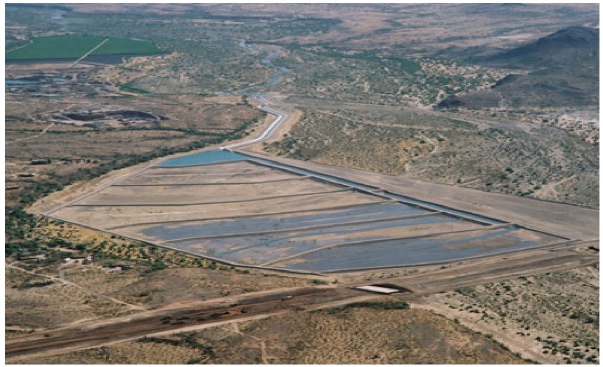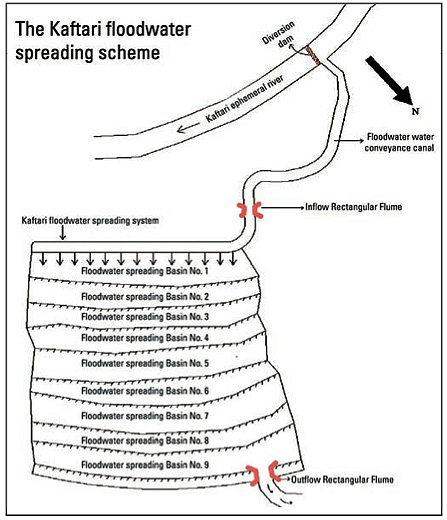Difference between revisions of "洪水控制/疏导水池"
Weichen Chen (talk | contribs) (→Resilience to changes in the environment) |
(→指南、运作和维护) |
||
| (27 intermediate revisions by 2 users not shown) | |||
| Line 1: | Line 1: | ||
| − | + | {{Language-box|english_link= Water Portal / Rainwater Harvesting / Groundwater recharge / Controlled flooding and Spreading basins | french_link= Coming soon | spanish_link= Coming soon | hindi_link= वाटर पोर्टल / वर्षाजल संचयन / भूजल पुनर्भरण / नियंत्रित बाढ़ और विपथन-फैलाव वाहिकाएं | malayalam_link= Coming soon | tamil_link= Coming soon | korean_link= Coming soon | chinese_link=洪水控制/疏导水池 | indonesian_link= Coming soon | japanese_link= Coming soon }} | |
| + | __NOTOC__ | ||
[[Image:controlled flooding icon.png|right|80px]] | [[Image:controlled flooding icon.png|right|80px]] | ||
[[Image:ControlledFlooding.jpg|thumb|right|200px|使用疏导水池补给地下水。图片来源:美国亚利桑那州(2002)]] | [[Image:ControlledFlooding.jpg|thumb|right|200px|使用疏导水池补给地下水。图片来源:美国亚利桑那州(2002)]] | ||
| − | + | 这是一项利用洪水的技术,通过修建引水建筑物和运河将河水疏导至一大片区域,从而补给地下水、池塘、灌溉土地和牧场。这个技术的原理是当少量的水以最慢的速度流过土地时不会破坏土壤表面。这包括[[Irrigation_-_Spate_irrigation|漫灌]],也包括通过运河将河水疏导至田地的标准灌溉渠方法。 | |
===适宜条件=== | ===适宜条件=== | ||
| − | + | 水流量大、水流湍急并且不适合传统灌溉方式的地方(漫灌系统应该在已经应用的地方大力推广)。 | |
| Line 13: | Line 14: | ||
! style="background:#f0f8ff;" | 劣势 | ! style="background:#f0f8ff;" | 劣势 | ||
|- | |- | ||
| − | | valign="top" | - | + | | valign="top" | - 对土地要求不高,因此比其它渗入方式性价比更高 <br> |
- 大部分河流中的沉淀物(如70%)会沉淀在土地上,有益于农业 <br> | - 大部分河流中的沉淀物(如70%)会沉淀在土地上,有益于农业 <br> | ||
| − | - | + | - 对于径流水渗入很有好处—伊朗的统计数据显示83.5%的河水依靠下渗<br> |
| valign="top" | - 需要大面积的土地 <br> | | valign="top" | - 需要大面积的土地 <br> | ||
| − | - | + | - 季节性河流的水量在时间和流量上难以预计,这将导致无法估计水流在土地上的流经面积以及对引水建筑物的破坏程度<br> |
| − | - | + | - 大量沉淀物会导致补给率逐渐降低。沉淀物还会造成农田比村庄地势更高,从而导致村庄发生洪涝灾害,甚至决堤<br> |
| − | - | + | - 修建河堤疏导洪水需要大量的人力资源(在厄立特里亚国,河堤高度是5-10米)<br> |
| − | - | + | - 如果设计不当会对下游造成负面影响。尤其是当洪水不会流入海洋时,所有的水已经流入水池,在一处抽水更有可能对另一处造成不良影响<br> |
|} | |} | ||
| Line 27: | Line 28: | ||
'''干旱的后果''': 农作物产量降低<br> | '''干旱的后果''': 农作物产量降低<br> | ||
'''潜在的原因''': 灌溉农作物的洪水量减少<br> | '''潜在的原因''': 灌溉农作物的洪水量减少<br> | ||
| − | '''增加 WASH 系统的适应性''': | + | '''增加 WASH 系统的适应性''': 种植防旱且生长周期短的作物;使农民种植的作物更具多样性 |
| − | + | 更多关于治理干旱的信息,请查看: [[Resilient WASH systems in drought-prone areas | 易干旱地区具有适应性的WASH系统]]。 | |
| − | ==== | + | ====洪水==== |
| − | + | 疏导水池十分适合洪水多发地区。这样可以将多余的河水疏导至别处,由此控制洪水。然而在洪水泛滥的地区,疏导水池的面积必须足以应对增大的雨量。另外,在降雨集中的时候,水流速度可能太快,以导致土壤被冲刷,或有可能水还没来得及渗入到地下就流走了。因此在这种情况下,增加植被(帮助土壤吸收更多水分)、增加湿地、保护防洪堤以及/或增加储水量都会很有益处。 | |
| − | === | + | ===修建、运作和维护=== |
| − | ''' | + | '''关于水泥的建议''': 建筑和隔板(例如水箱、大坝、水道和水井)出现裂缝的常见原因是在混合和使用水泥时出错。首先,很重要的一点是使用的成分一定要纯:干净的水、沙子和岩石,这些成分必须充分混合。第二,混合时使用的水尽量少:混凝土或水泥成形即可,宁可干点,也不要成为液体。第三,在固化过程中混凝土或水泥需要保持一定的水分,至少维持一周。同时,载固化过程中应该用塑料、大树叶或其他材料覆盖在引水建筑物上以保持水分。 |
| − | ''' | + | '''具体建议''': |
| − | * | + | * 最好将精力集中在低成本的引水建筑物上,从而避免使用复杂的技术方法。重点应在提高现有的流入量。 |
| − | * | + | * 如果通过控制洪水进行灌溉,农民应该更积极地参与开发改进防洪系统。新系统应该在现有方法和土地权的基础上改进,而不是像过去那样破坏或违反。 |
| − | ==== | + | ====修建前的考虑==== |
| − | + | 洪水多变,因此很难用传统的降雨径流模式预测,因为降雨通常不与流入防洪系统的季节性河流的径流相关。为抵挡凶猛洪水而修建大规模永久性的引水建筑物造价太高,而且仍可能遭到破坏并出现淤积现象。虽然,淤积能带来营养物质,但同时也会对洪水灌溉造成一个严重问题——季节性河流中的沉淀物大约占3%-10%,沉淀物小有泥沙,大有巨砾。泥沙会堵塞管道,抬高耕地并导致河道改道,从而错过引水建筑物。大量的漂浮物也会导致流入量出问题。 | |
| − | + | 以下有五点建议: | |
| − | * | + | * 洪水过后,重建该系统的某些部分比设计更持久的引水建筑物性价比更高。传统的引水建筑物不仅效果更好,而且费用比其他方式低得多——它能分隔洪水(泥沙淤积严重的河水不会流向陆地)。 |
| − | * | + | * 改进河水分流并保持土壤水分比仅仅提高引水建筑物的效率更有益处 (请参阅 [[蓄水围 | 堤岸]])。应该在还未普及该方法的地方进行推广。 |
| − | * | + | * 由于洪水极不稳定,因此需要改变传统的系统使其更加灵活。在过去,洪水灌溉的灵活性体现在农民身上,因为他们随时需要转移到其他地方。 |
| − | * | + | * 经证实,逐渐加固现有传统流入量的性价比与大规模干预相同,并且效果比后者更好。 |
| − | * | + | * 没有闸门的简易引水建筑物由石笼、碎石砌墙或混凝土建成。农民十分熟悉这种方法,因此更容易进行维护。限制流量的引水建筑物和溢洪道需要位于运河的上游,以防止洪流损坏运河和灌溉设施。 |
| − | ==== | + | ====运作和维护==== |
| − | + | 系统应该能自动进行常规运作和修理,但是也希望得到政府部门的支持: | |
| − | * | + | * 洪水系统根据其规模依赖共同管理和沟通。工程的维护协议不应该只拘泥于形式,农民应该积极推动。然而,任何用户组织应该基于某个流域或公共区域而成立。 |
| − | * | + | * 推土机的盛行使得农民能更容易地修建或修补被损的建筑物。但问题是上游的农民可以修建更大的建筑物,因此有时候对下游产生了巨大的影响。而且因为推土机使用和维护成本高,农民很难承担这些费用。小型农民群体也无力提供支持,因此最好能由当地政府提供支持,或者由私有企业提供补助。 |
| − | === | + | ===实地经验=== |
| − | [[Image:FloodwaterSpreading.jpg|thumb|right|200px| | + | [[Image:FloodwaterSpreading.jpg|thumb|right|200px|洪水疏导计划方案。点击放大。 <br> 图片来源: [http://unesdoc.unesco.org/images/0014/001438/143819e.pdf ''在半干旱地区实施含水层补给(MAR)策略。''] 联合国教科文组织(UNESCO)。]] |
| − | ==== | + | ====伊朗==== |
| − | + | Dorz Sayban平原位于伊朗Larestan郡东南部115千米,由于当地过度开采地下水导致水位急剧下降(1.5米/年),并且地下水水质也在恶化。该平原3500公顷都需要地下水灌溉。为了控制水位降低率,该地区分别在1983年和2001年设计并修建了5个洪水疏导系统用于补给地下水。 | |
| − | + | 2002-2003年之间使用Kaftari洪水疏导系统中的矩形水池测量了9次洪水的流入量和流出量。最大的流入量和流出量分别是20.3和7.26 立方米/秒。9次洪水的流入和流出系统的总量分别是886,000立方米和 146,000立方米。因此,流入系统中83.5%的水进入含水层,只有一小部分蒸发流失。这说明洪水疏导系统对于地下水补给作用显著。 | |
| − | + | 超过70%的悬移质沉淀在系统中。这将不可避免造成系统堵塞并降低系统的效率,但同时也会改善土壤利于农耕。另外,含水层补给管理会提高地下水的水质,因为洪水的导电性(0.3-0.4 dS/m)比地下水(2.0-9.0 dS/m)低得多。 | |
| − | === | + | ===指南、运作和维护=== |
| − | * [http://www.iaea.org/technicalcooperation/documents/Brochures/sust-groundwater.pdf | + | * [http://web.archive.org/web/20151106164515/https://www.iaea.org/technicalcooperation/documents/Brochures/sust-groundwater.pdf 非洲东部南部地下水资源的可持续发展] 。国际原子能机构。 |
| − | === | + | ===鸣谢=== |
| − | * CARE | + | * CARE Nederland,初步研究: [[ Resilient WASH systems in drought-prone areas | 易干旱地区具有适应性的WASH系统 ]]。2010.10。 |
| − | * Gale, Ian, [http://unesdoc.unesco.org/images/0014/001438/143819e.pdf | + | * Gale, Ian, [http://unesdoc.unesco.org/images/0014/001438/143819e.pdf 在半干旱地区实施含水层补给(MAR)策略。] 联合国教科文组织国际水文项目 (IHP), 2005。 |
| − | * [http://www.colusarcd.org/ | + | * [http://www.colusarcd.org/ 有关气候变化的未知影响。] 美国 Colusa County Resource Conservation District。 |
Latest revision as of 00:09, 7 April 2016
| |
|
|
|
|
|
|
|
|
这是一项利用洪水的技术,通过修建引水建筑物和运河将河水疏导至一大片区域,从而补给地下水、池塘、灌溉土地和牧场。这个技术的原理是当少量的水以最慢的速度流过土地时不会破坏土壤表面。这包括漫灌,也包括通过运河将河水疏导至田地的标准灌溉渠方法。
适宜条件
水流量大、水流湍急并且不适合传统灌溉方式的地方(漫灌系统应该在已经应用的地方大力推广)。
| 优势 | 劣势 |
|---|---|
| - 对土地要求不高,因此比其它渗入方式性价比更高 - 大部分河流中的沉淀物(如70%)会沉淀在土地上,有益于农业 |
- 需要大面积的土地 - 季节性河流的水量在时间和流量上难以预计,这将导致无法估计水流在土地上的流经面积以及对引水建筑物的破坏程度 |
应对环境变化的适应性
干旱
干旱的后果: 农作物产量降低
潜在的原因: 灌溉农作物的洪水量减少
增加 WASH 系统的适应性: 种植防旱且生长周期短的作物;使农民种植的作物更具多样性
更多关于治理干旱的信息,请查看: 易干旱地区具有适应性的WASH系统。
洪水
疏导水池十分适合洪水多发地区。这样可以将多余的河水疏导至别处,由此控制洪水。然而在洪水泛滥的地区,疏导水池的面积必须足以应对增大的雨量。另外,在降雨集中的时候,水流速度可能太快,以导致土壤被冲刷,或有可能水还没来得及渗入到地下就流走了。因此在这种情况下,增加植被(帮助土壤吸收更多水分)、增加湿地、保护防洪堤以及/或增加储水量都会很有益处。
修建、运作和维护
关于水泥的建议: 建筑和隔板(例如水箱、大坝、水道和水井)出现裂缝的常见原因是在混合和使用水泥时出错。首先,很重要的一点是使用的成分一定要纯:干净的水、沙子和岩石,这些成分必须充分混合。第二,混合时使用的水尽量少:混凝土或水泥成形即可,宁可干点,也不要成为液体。第三,在固化过程中混凝土或水泥需要保持一定的水分,至少维持一周。同时,载固化过程中应该用塑料、大树叶或其他材料覆盖在引水建筑物上以保持水分。
具体建议:
- 最好将精力集中在低成本的引水建筑物上,从而避免使用复杂的技术方法。重点应在提高现有的流入量。
- 如果通过控制洪水进行灌溉,农民应该更积极地参与开发改进防洪系统。新系统应该在现有方法和土地权的基础上改进,而不是像过去那样破坏或违反。
修建前的考虑
洪水多变,因此很难用传统的降雨径流模式预测,因为降雨通常不与流入防洪系统的季节性河流的径流相关。为抵挡凶猛洪水而修建大规模永久性的引水建筑物造价太高,而且仍可能遭到破坏并出现淤积现象。虽然,淤积能带来营养物质,但同时也会对洪水灌溉造成一个严重问题——季节性河流中的沉淀物大约占3%-10%,沉淀物小有泥沙,大有巨砾。泥沙会堵塞管道,抬高耕地并导致河道改道,从而错过引水建筑物。大量的漂浮物也会导致流入量出问题。
以下有五点建议:
- 洪水过后,重建该系统的某些部分比设计更持久的引水建筑物性价比更高。传统的引水建筑物不仅效果更好,而且费用比其他方式低得多——它能分隔洪水(泥沙淤积严重的河水不会流向陆地)。
- 改进河水分流并保持土壤水分比仅仅提高引水建筑物的效率更有益处 (请参阅 堤岸)。应该在还未普及该方法的地方进行推广。
- 由于洪水极不稳定,因此需要改变传统的系统使其更加灵活。在过去,洪水灌溉的灵活性体现在农民身上,因为他们随时需要转移到其他地方。
- 经证实,逐渐加固现有传统流入量的性价比与大规模干预相同,并且效果比后者更好。
- 没有闸门的简易引水建筑物由石笼、碎石砌墙或混凝土建成。农民十分熟悉这种方法,因此更容易进行维护。限制流量的引水建筑物和溢洪道需要位于运河的上游,以防止洪流损坏运河和灌溉设施。
运作和维护
系统应该能自动进行常规运作和修理,但是也希望得到政府部门的支持:
- 洪水系统根据其规模依赖共同管理和沟通。工程的维护协议不应该只拘泥于形式,农民应该积极推动。然而,任何用户组织应该基于某个流域或公共区域而成立。
- 推土机的盛行使得农民能更容易地修建或修补被损的建筑物。但问题是上游的农民可以修建更大的建筑物,因此有时候对下游产生了巨大的影响。而且因为推土机使用和维护成本高,农民很难承担这些费用。小型农民群体也无力提供支持,因此最好能由当地政府提供支持,或者由私有企业提供补助。
实地经验
伊朗
Dorz Sayban平原位于伊朗Larestan郡东南部115千米,由于当地过度开采地下水导致水位急剧下降(1.5米/年),并且地下水水质也在恶化。该平原3500公顷都需要地下水灌溉。为了控制水位降低率,该地区分别在1983年和2001年设计并修建了5个洪水疏导系统用于补给地下水。
2002-2003年之间使用Kaftari洪水疏导系统中的矩形水池测量了9次洪水的流入量和流出量。最大的流入量和流出量分别是20.3和7.26 立方米/秒。9次洪水的流入和流出系统的总量分别是886,000立方米和 146,000立方米。因此,流入系统中83.5%的水进入含水层,只有一小部分蒸发流失。这说明洪水疏导系统对于地下水补给作用显著。
超过70%的悬移质沉淀在系统中。这将不可避免造成系统堵塞并降低系统的效率,但同时也会改善土壤利于农耕。另外,含水层补给管理会提高地下水的水质,因为洪水的导电性(0.3-0.4 dS/m)比地下水(2.0-9.0 dS/m)低得多。
指南、运作和维护
- 非洲东部南部地下水资源的可持续发展 。国际原子能机构。
鸣谢
- CARE Nederland,初步研究: 易干旱地区具有适应性的WASH系统 。2010.10。
- Gale, Ian, 在半干旱地区实施含水层补给(MAR)策略。 联合国教科文组织国际水文项目 (IHP), 2005。
- 有关气候变化的未知影响。 美国 Colusa County Resource Conservation District。


